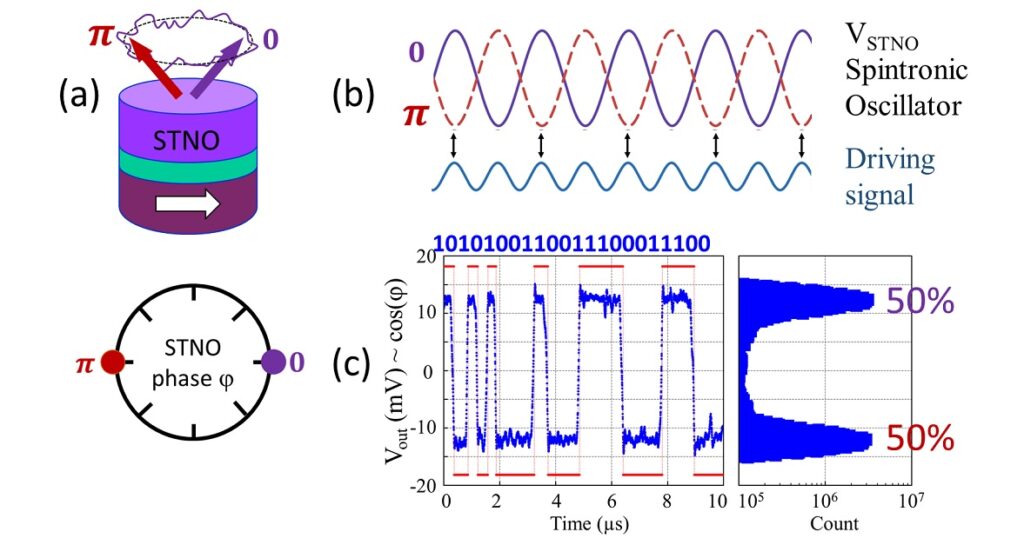Unbiased random bitstreams are essential for encryption, secure communication, and unconventional computing, yet true randomness without bias remains challenging in hardware. By harnessing nanoscale thermal magnetization fluctuations in spintronic nano-oscillators, the AI and RF teams at SPINTEC and collaborators introduce a new approach to generating fully unbiased bitstreams.
Thermal fluctuations provide an efficient and almost cost-free means of generating truly random bitstreams of 0 and 1, distinguishing them from predictable pseudo-random sequences. Thermal fluctuations are present in all physical systems. Thus, it could be expected that it is straightforward to generate random bitstreams from a fluctuating two-level system, described by two energy minima separated by an energy barrier. However, most hardware implementations suffer from bias, leading to unequal energy minima and energy barriers resulting in significant deviations from equal fractions of 0 and 1 levels. This will compromise their inherent unpredictability.
Operating principle for generating unbiased random bit-streams: (a) The magnetization oscillations of the STNO free layer with two stable phase states under synchronization. (b) The phase φ of the STNO signal VSTNO adjusts to the driving signal phase, at two degenerate and π-shifted states. (c) Experimental time-traces of the readout circuit signal Vout ~ cos(φ), and the corresponding histogram, revealing 50% probability of both states.
The SPINTEC team discovered that the phase dynamics of oscillators presents an ideal foundation for generating unbiased random bitstreams. When synchronized to an external signal at twice its own frequency, the oscillator phase settles in one of two stable, π-shifted, states, see Fig. 1(a, b), forming two equivalent potential wells that ensure symmetry and balance. In the presence of thermal noise, transitions between these states occur stochastically, with in average no state preference, fulfilling the core requirement for unbiased true randomness in bitstream generation. The SPINTEC team has realized this concept using spin-torque nano-oscillators (STNOs) based on magnetic tunnel junctions, ideal for their nanoscale dimensions, CMOS compatibility, room temperature operation and high-frequency capabilities. Their free layer magnetization can exhibit auto-oscillations that are converted into electrical voltage signals VSTNO(t) via magneto-resistive effects, see Fig. 1(a, b). The STNO’s phase φ is extracted from VSTNO through a special phase readout circuit which outputs a voltage Vout ~ cos(φ) revealing thermal-noise-induced, stochastic transitions between two levels with equal occupancy, see Fig. 1(c). Validation through the NIST statistical test suite confirmed the corresponding digitized bitstream’s suitability for secure encryption applications
Teams: Microwave devices, Artificial Intellingence
Collaboration: Iberian Nanotechnology Laboratory (INL), National Institute of Standards and Technology (NIST), University of Maryland
Funding: ANR-NSF Stochnet ANR-21-CE94-0002-01, Grenoble INP-UGA Bourse Présidence and MIAI@Grenoble Alpes (ANR-19-P3IA-0)
Further reading: Unbiased random bitstream generation using injection-locked spin-torque nano-oscillators, N.-T. Phan, N. Prasad, A. Hakam, A. Sidi El Valli, L. Anghel, L. Benetti, A. Madhavan, A. S. Jenkins, R. Ferreira, M. D. Stiles, U. Ebels and Ph. Talatchian Phys. Rev. Applied. 21, 034063 (2024), hal-04666735v1
Contacts: Philippe TALATCHIAN, Ursula EBELS

